The plinth is protected from moisture to increase its service life. The base is a supporting structure and can bear the weight of the building together with the equipment and people. When wet and freezing, water particles expand and deform the material. The base / plinth waterproofing protects the support wall from collapse. The protective layer insures the interior against moisture penetration.
The need for waterproofing the basement inside and outside
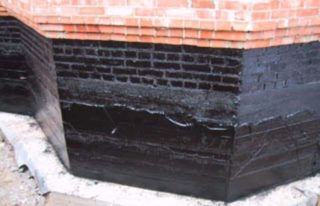
Insulation from moisture is required, especially in the case of a high level of soil water standing. A wet base loses some of its strength and deteriorates from temperature changes that often occur in the ground. The outer part of the retaining wall takes on the action of rain streams, snow drifts, contacts with swelling soils. Sometimes the waterproofing of the basement from the outside does not fulfill the set goals, and the protective layer is additionally installed from the inside.
Insulation is done at the same time as moisture insulation, because a layer of mineral wool, foam must be installed on a waterproof material. The heat transfer of the insulation increases when it gets wet, so it no longer protects the room from the cold, so the installation of waterproofing on the walls of the basement is a necessary procedure.
Moisture protection methods
Effective protection of the plinth inside and outside prolongs the service life. The outer layer is mounted during the construction of the foundation and basement, so as not to dig out the soil later for the installation of insulating materials. Sometimes permanent formwork is used if the base is made of concrete. Such a shell simultaneously protects against dampness and insulates the structure.
A horizontal layer of insulation is placed on the upper surface of the plinth in front of the wall. So moisture is not transferred to the vertical fence and protects the rooms on the ground floor from dampness. The material for the transverse and vertical layer is selected on the advice of specialists who take into account the type of soil, climate, the purpose of the building and other conditions.
A drainage system at the site must be built to reduce the pressure of the ground fluid. The drainage from the foundation reduces the liquid volumes in the area of the base. It is important to arrange a blind area around the house at ground level.
Vertically
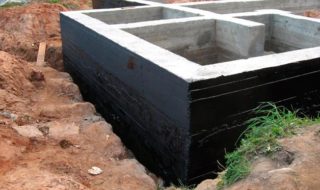
External protection protects the base from penetration of soil moisture and transferring it to the surface of the basement wall. The inner layer protects the microclimate of the room from dampness and insures the insulation from getting wet.
The surface of the walls is cleaned, cracks and cracks are sewn with a cement-sand mortar for a better fit of the material. The vertical layer is glued or spread over the area.
The insulators are:
- roll materials;
- bituminous mastics;
- liquid glass;
- paints and varnishes.
The combined version of roll-up waterproofers followed by the use of liquid silicate glass or mastics is a reliable way to protect the basement. The composite method has been successfully applied to concrete foundations and brick structures.
Horizontally

A horizontal membrane from dampness is installed after the completion of the construction of the base and before the construction of the walls. The plinth is insulated at the top and bottom to keep the vertical structures of the house from moisture.
The insulation layer is made in the form:
- waterproofing between the foundation and the plinth;
- membrane between the base and the wall.
If the foundation is arranged so that its upper edge plays the role of a plinth, the protection is installed once, but more layers are used.
Roll materials are used, for example, roofing material, euroruberoid with sand dusting or roofing felt. The latter type is rarely used due to its short service life. Hot mastics are used for gluing, molten bitumen or the material is applied using cold compounds for gluing waterproofing. Roofing material is placed in 2 layers.
Basement waterproofing options
The waterproofing is applied to the plinth area with brushes, rollers, trowels and spatulas. To heat bitumen or mastic, they take burners, you will need a reinforced mesh, as well as the insulator itself.
The waterproofing device is carried out according to the technology:
- spreading;
- staining;
- impregnation;
- pasting.
Roll materials, paints and mastics must adhere well to the surface of the supporting wall. Impregnations resist negative factors, penetrating deeply into the base. Hydroisols are chosen with high strength, low abrasion rates and resistance to ultraviolet radiation.
It is advisable to purchase primers, paints, rolls and bitumen compositions from one company for the best interaction in a combined version.
Smearing
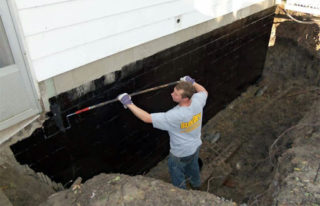
Simple and affordable processing is used on all types of surfaces. Several layers with a thickness of 4 - 10 mm are created. The composition is easy to apply, creates a uniform coating without seams. Works effectively on concrete and when waterproofing brick plinths.
The resinous base does not conduct liquid, but allows air to pass through. Lubricants are applied to untreated surfaces, so labor costs are reduced. Almost all types of coating mastics are inexpensive and are classified as environmentally friendly materials.
Disadvantages are manifested in low resistance to wear and the action of temperature changes, the formation is destroyed by impact. Homemade solutions need to be constantly warmed up for work, so it is better to use ready-made cold mastics.
Dyeing
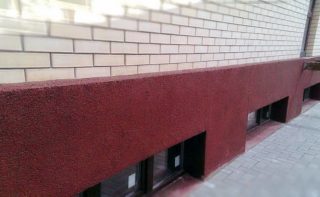
Use protective varnishes that are easy to apply and commercially available at an affordable price. In the city, acids, salts, alkalis, and other pollution act on the basement, therefore they choose acrylic paints on a solvent. The owners of the suburban sector use water-dispersion compositions.
Before use, a primer is applied to the leveled surface, multifunctional acrylic-based products are used. Such compositions improve the adhesion of the subsequent paint coat to the substrate. For porous walls, take water-repellent varnishes, which reduce water absorption and increase resistance to soil fluids.
Paints and varnishes insulate ground structures, but more often such protection is one of the elements of the complex protection of the basement from destruction. Works well in sandy, rocky and other stable soils.
Impregnation
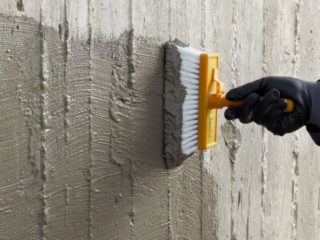
Penetrating agents contain polymers based on cement, quartz. The compositions are diluted with water, then applied with a roller or brush to the base area. Most often used for internal processing of the base. The impregnation penetrates into the thickness, the polymers expand and fill the pores. The moisture resistance of the material increases.
Effective impregnation has positive qualities:
- increases resistance to frost;
- increases the strength of the material, protects the reinforcement from corrosion;
- resists the action of aggressive chemicals.
The surface is not prepared if only the built-up base is impregnated. The old support walls are pre-degreased. When working, personal protective equipment is used. The compositions are applied to concrete and brick in a certain temperature regime; in winter they cannot be used.
Pasting
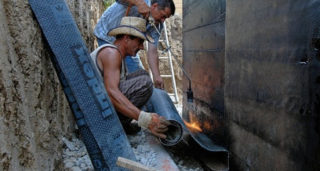
Roofing material is glued on hot molten bitumen, and in the Euro-roofing material there is a layer that is heated by a burner. At the same time, the surface of the wall is heated, and the sheets of material are pressed over the entire area. Synthetic films are applied in 2 layers, with the first placed vertically and the second placed horizontally.
Advantages of the pasting method:
- savings on insulation costs due to low cost;
- materials are environmentally friendly;
- adhere well to the surface, thanks to the mastic and a special layer.
Roll insulators are characterized by low mechanical strength, they can be easily damaged by shock. Roofing material and roofing felt poorly resist the chemical aggressiveness of the surrounding space. The surface of the walls is pre-leveled, and the gluing process can be performed by a person with experience.
Do-it-yourself filling of cracks and caverns
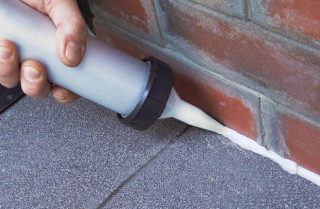
Waterproofing begins with preparatory work. This stage can be performed independently, without the involvement of masters.
Preparation stages:
- the basement is cleaned of layers of solution, dust;
- close up cracks, cracks, along the way leveling defects horizontally and vertically;
- wait for the solution to dry;
- the working area is primed with reinforcing compounds.
You can prepare the primer yourself. For ten liters of the future composition, 10 liters of gasoline and 300 g of heated bitumen will be needed. The product hardens soon, so you need to apply it quickly. You can use molten resin instead of a primer. The surfaces are smoothed, insulating materials stick to them easily.
Features of the internal moisture protection of the base
In the basement floor there are garages, basements, workshops, therefore attention is paid to the hydro and thermal insulation of the retaining wall. In such rooms, not only the inner wall area is protected, but also the floor surface.
Impregnation with polymer compounds is used to maximize the clogging of pores in building materials to reduce moisture conductivity. Comprehensive protection from a primer and pasting with an insulator works better.
The walls inside are insulated simultaneously with moisture insulation so that the mineral wool does not get wet. Such material is taken so that it is possible to make plaster on it, put tile or ceramic tiles. For plaster, a metal mesh is mounted to increase the adhesion of the cement-sand mortar with bitumen.








